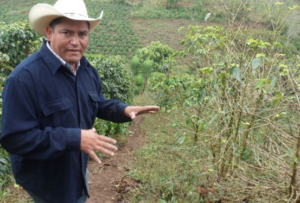Recently, I had the privilege of participating in the first Annual General Meeting of Regeneration Canada, an organization dedicated to growing the regenerative agriculture movement. It was a joy to be with such warm, passionate people and to learn about this practical and profound way of relating to the life of the land. Not surprisingly, the more I understand this movement, the more I see deep parallels with my own work inviting people to steward their organizations and communities as living ecosystems.
What I have learned is that conventional agriculture achieves short-term increases in yield but depletes the soil’s fertility in the process, requiring ever more — and ever more costly — artificial intervention. Worst of all, conventional methods of farming lead to a long list of unsustainable and ultimately catastrophic problems, including soil erosion, diminished nutritional value of our food, and release of significant levels of carbon into the atmosphere. (Can you envision parallels between all of this and the conventional, command-and-control, too-often toxic world of work?)
In contrast, regenerative agriculture is focused on cultivating the natural health and biodiversity of the soil, regenerating what has been degraded. As science has discovered more about soil’s composition, functions and needs, a small number of farmers are starting to work with life’s natural capacities instead of against them. In this way, they are able to counteract the detrimental effects of conventional farming and — importantly — still maintain high yields.
“It is the organisms that live in soil that enable plants to thrive: bacteria, fungi, protozoa, nematodes, mites, springtails, and yes, nature’s plow, the earthworm,” explains one enthusiast. “These organisms and more, collectively called ‘soil life,’ feed on organic matter in the soil and help convert it, along with soil minerals, into the vitamins, hormones, disease-suppressing compounds, and nutrients that plants need to grow.”
For another level of depth in understanding, Ethan Roland Soloviev of Terra Genesis offers a helpful comparison with organic farming. Here are some excerpts:
1. Regenerative agriculture emerges from a different paradigm than organic. In regenerative agriculture, the paradigm could be named, “Evolve Capacity”. In organic agriculture, the paradigm is mostly, “Do Less Harm”.
2. Regenerative Agriculture is more holistic, inclusive and expansive than organic, especially in the social justice and cultural equity realms. Theoretically, you could have a ‘certified organic’ farm that is oppressive to people who work there and still be “organic”. Not so with regenerative agriculture.
3. Organic is defined by a set of technical checklists, mostly what “not to do” (this goes with the “do less harm” paradigm). For example, “Do not use synthetic chemicals. Do not use GMOs.” Regenerative agriculture works from a set of principles, which seek to unleash the innate potential of any agricultural system.
4. Organic agriculture uses a pre-decided upon set of practices & standards. Regenerative agriculture is based on increasing & enhancing processes (natural/ecological and human/social/design/decision-making) and on observable outcomes (increases in multiple dimensions of living, social capital and cultural capital).
(Again, in all of this, can you see parallels with emerging perspectives and approaches in the world of work, such as self-organization, resilience, agility — living systems concepts, all of them?)
At the Regeneration Canada meeting, Monika Firl, Director of Sustainability at Co-op Coffees, told me about the dramatic results one of her coffee growers has experienced with regenerative agriculture. She writes in a blog post:

“That harvest, Oscar was already getting yields of more than 50qq per hectare of high quality, organic and fairtrade certified coffee from his fields. But it wasn’t just that Oscar had managed to achieve such great yields that rocked me. It was that he was able to achieve this during the peak of the leaf-rust crisis, while being surrounded by utter and complete devastation in the plots of neighbouring conventional and natural farmers…. While hundreds of millions of dollars were being spent to promote more persistent fungicide spraying and buckling down for the ‘dirty-but-necessary’ war against the leaf-rust fungus (Hemileia vastatrix) ravaging the coffee lands, Oscar had reverted to a simple, yet intensive, plan to strengthen natural systems.”
Monika also told me about her own conversion, in a tone full of wonder and delight: “Once I understood more about how soil works, I had a completely different relationship with my little patch of land in our local community garden. The way I walk on the land is different. How I feel and what goes through my mind when I’m watering it is different: I’m not watering the plant; I’m watering the micro-organisms! And then they do the work of feeding my vegetables!”
“This is what I want to help people feel about their organizations,” I told her. A sense of wonder and participation with something precious and alive and beyond our full comprehension. A feeling of reverence and responsibility. A sense of stewardship and care.
As I write in The Age of Thrivability: In our organizations and communities…, stewardship is less a role or a title and more a commitment to tend to [the necessary] fertile conditions, offered from a stance of reverence for the life in each of us and between us, as well as for the transcendent potential that we may express together. In this way, what we are stewarding is the fullness of a system’s ongoing ability to thrive — its thrivability.
In fact, this connects with the larger vision of the regenerative agriculture movement. As Soloviev and Gregory Landua write in their paper, Levels of Regenerative Agriculture: “Deeply regenerative agriculture can exist only if it is completely interwoven into a thriving regenerative culture. This includes the songs, stories, myths, rituals, foods, ceremonies and music that transform agriculture from a functional economic activity to a spiritually rich and emotionally fulfilling central heart of an agricultural community.”
“To move into an Age of Thrivability,” I write further, “we need to see ourselves more fully as active stewards of life’s unfolding process and as part of a larger living world. With this broader view, we can see that our organizations have the potential to be places where we are nourished by our relationships and by the opportunity to contribute and develop our gifts. Where we can be held appreciatively by people and place. Where we can experience beauty, wholeness and healing within our communities and our workplaces. Where we can grow into wisdom alongside each other, with trust that this is the most direct path to effective action. And where these are the express purposes of coming together. Indeed, the organization is poised to be transformed from the too-often toxic workplace to the sacred temple of our times.”
In virtually every realm of our lives, we are faced with a choice: continue down the conventional path of alienation from life, despite that pathway’s inevitable devastation; or forge a new path of greater alignment with life, with all its promise and potential. Wherever we come together in shared effort, whether in a farm, a factory, a software development team or a family, we can — and, indeed, must— cultivate it as the fertile, perhaps even sacred, ground of our belonging within the whole of life.
This blog post was originally published on Michelle Holliday’s website, on May 23, 2018. Michelle is an advisor and a good friend of Regeneration Canada. She is a consultant and author of book The Age of Thrivability.




